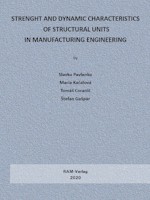|
 |
Introduction
Manufacturing engineering is a field that is functionally and parametrically broad in its extent. For this reason, it is necessary to structure manufacturing engineering on the principles of trade union profiling in the field of mechanical engineering, agriculture, wood manufacturing and processing, food industry, utilities industry etc. The term manufacturing engineering does not only include manufacturing machines that implement manufacturing technologies, but the given field also includes a variety of machinery that simultaneously participate in the given process. This peripheral equipment of manufacturing engineering also embraces other technical components that control, monitor, evaluate the given process in order to achieve a system optimization. It is important to note that it would be difficult to find a product which would not use at least one of the parts of manufacturing engineering systems during its manufacture or disposal.
A machine has always been, is and will be the technical progress. The basis of every economy is the progressiveness of manufacturing engineering since it manufactures components for all industries. Technical requirements in manufacturing engineering are constantly leading to an increase of the technical level of manufacturing equipment. Profound knowledge of scientific fields precedes a successful fulfilment of the technical requirements. Structural units of manufacturing machines are complex mechanisms that must work reliably and safely with an emphasis on their important function. These units create new objectives for their research and optimization.
There are industrial sectors in which a person can encounter manufacturing machines and equipment, and there are impacts occurring during their operation. These impacts have, on one hand, their significance, e.g., work of hammers, mechanical hammers, vibrating conveyors etc.; and on the other hand, there are impacts that occur during operation which are undesired accompanying phenomenon. They increase noise, deterioration and stress of structural units which can result in an incorrect operation of manufacturing engineering components. These are mostly gears, rotors, cam mechanisms and other structural units in which excessive oscillation occurs. Design parameters of the given units should be determined in a way that eliminates an occurrence of sustained motion with an intensive impact. Manufacturing operation influences force effect which results in various changes, e.g., change of velocity, amplitudes, frequencies etc. These changes have a direct impact on reliability of structural units. Calculations are based on theoretical assumptions which are often not the same as operating conditions, such as extremely low or high temperatures, corrosion and others. Therefore, it is necessary to consider not a perfect structural unit with perfect properties. This fact is related to the current tests of
structural units which are performed under conditions similar to the operating ones, e.g., under cyclic force, combined loading etc. Time characteristics have a significant effect on strength of structural units.
The present publication is divided into several parts based on motivation and analysis of strength and dynamic characteristics of structural units in manufacturing engineering. The beginning of the publication is devoted to the motivation and aims of the work, as well as to the brief summary of the given field and it continues with the theoretical essentials for research and optimization of strength and dynamic characteristics in manufacturing engineering. Another part of the publication is the practical part that is devoted to strength analysis, dynamic analysis together with modal analysis, and to experimental measurement of the screw conveyor drive. Subsequently, the work continues with optimization of the defective unit and the results that compare the calculated and the measured values with the new findings in the given field.
